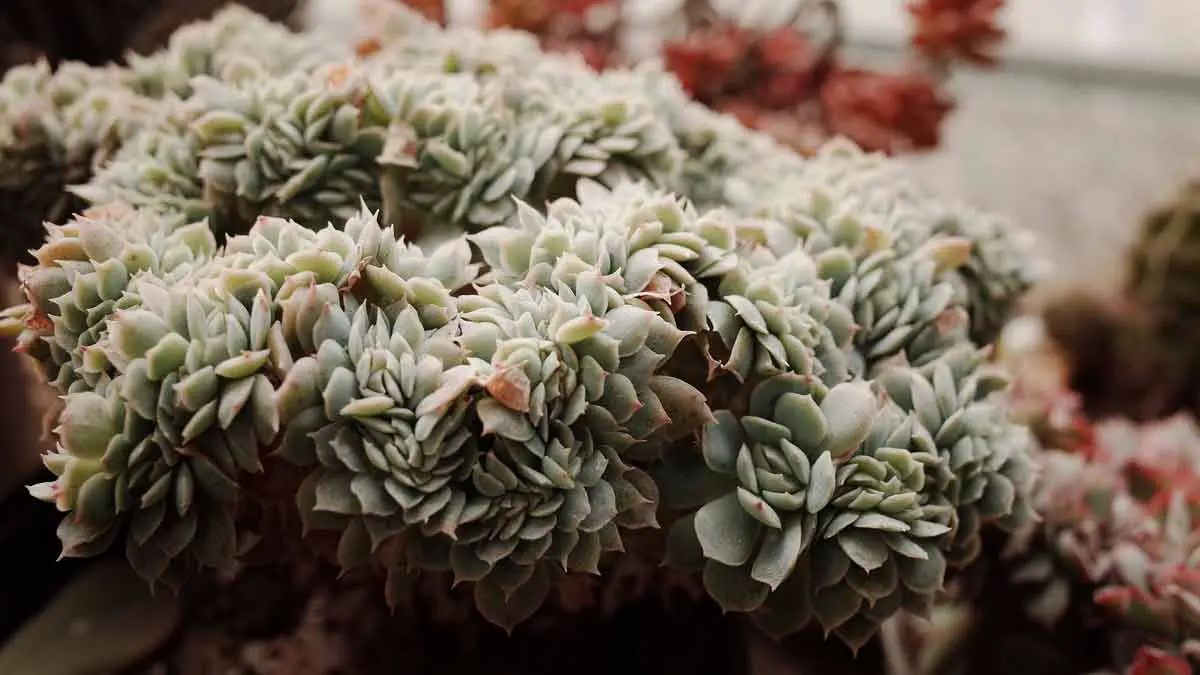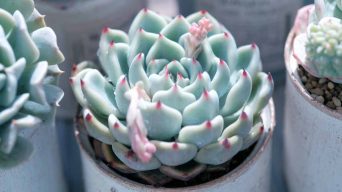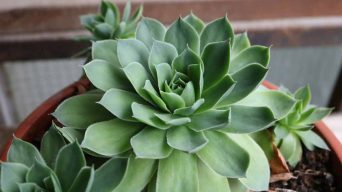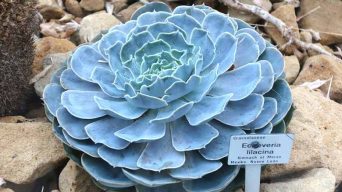Echeveria succulents are cherished for their stunning rosettes and low-maintenance nature, making them popular among plant enthusiasts.
However, to maintain their effortless beauty and ensure optimal growth and health, it is crucial to understand the art of pruning these eye-catching plants.
This guide will teach you the importance of pruning Echeveria succulents, when and why you should prune them, techniques, common mistakes to avoid, aftercare tips, and propagation methods.
The Importance Of Pruning Echeveria Succulents
Pruning Echeveria succulents is crucial to maintaining their health and ensuring optimal growth.
Removing overgrown, damaged, or dying leaves and stems allows the plant to focus its energy on producing new foliage and thriving in its environment.
Aside from promoting vigorous growth, regular pruning helps prevent common issues such as rot and pest infestations.
For example, when dead leaves are left unattended around the base of an Echeveria gibbiflora or an Echeveria imbricata plant, they create a perfect habitat for pests like mealybugs and aphids to thrive.
In conclusion, cultivating aesthetically appealing and healthy Echeveria succulents relies on consistent pruning practices.
When And Why To Prune Echeveria Plants
To maintain the health and growth of your Echeveria succulents, it’s crucial to prune them when you observe overgrown or dying parts.
It’s best to do this at the start of the growing season in spring, as it stimulates new growth and prevents legginess.
Signs That Pruning Is Needed
Recognizing the signs that indicate pruning is necessary can make all the difference in keeping your Echeveria succulents healthy and thriving.
One common sign that it’s time to prune is when the Echeveria plant has grown leggy, with elongated stems and sparse leaves due to insufficient light exposure.
Another key indication for pruning is when you notice dead or yellowing leaves on your Echeveria plants.
Removing these unhealthy parts prevents rot from spreading throughout the plant and helps maintain overall health.
Additionally, be vigilant about any signs of pests, such as mealybugs or aphids, which leave telltale cottony residue or sticky sap on foliage.
Infestations are often resolved by carefully cutting away affected areas before applying treatments like insecticidal soap or rubbing alcohol.
Best Time To Prune
Pruning your Echeveria succulents at the right time is crucial for their optimal growth and health.
The best moment to trim these plants typically falls early in the growing season, during spring.
This renewal period allows the Echeveria to benefit from a preserved energy boost straight into regrowth.
To illustrate, imagine you have an Echeveria “Black Prince” showing signs of needing a trim – leggy stems or overcrowded leaves, for example.
By pruning it in early spring, you create space for impressive new foliage or flowers to emerge while minimizing stress on the plant’s overall vitality.
Benefits Of Pruning
Pruning your Echeveria succulents is an essential task that comes with a range of benefits.
For one, pruning can help control the growth and size of the Echeveria plant, especially when they are getting too big for the container or space available.
Another benefit of pruning is that it removes damaged or diseased leaves and stems, which reduces the risk of spreading pests or fungal diseases within the plant.
Furthermore, if you notice any leggy or stretched-out areas on your Echeveria plant due to insufficient light levels or poor watering habits, pruning can help rejuvenate those areas by encouraging new growth in a healthier direction.
How To Prune Echeveria Plants
To ensure the health and prosperity of your Echeveria succulent, it’s crucial to know how to prune it properly.
With the right tools and techniques for your specific plant type, pruning can be a beneficial way to promote new growth, control size, and keep pests at bay.
The Tools Required For Pruning
To correctly prune echeveria succulents, you’ll need a few essential tools. Here’s what you need to gather:
- Sharp scissors or pruning shears
- A clean and sharp gardening knife or pair of shears
- Rubbing alcohol and a cotton swab for disinfecting the tools before use
- Gloves to protect your hands from prickly parts of the plant
These tools will simplify the job and ensure you don’t harm your Echeveria while pruning.
Remember to clean and disinfect your tools before pruning each time to prevent the spreading of infection or disease between plants.
Techniques For Different Types Of Echeveria
Different types of Echeveria succulents may require other pruning techniques.
For example, the Echeveria shaviana produces offsets that can be separated from the mother plant and replanted in their own pot.
The Echeveria gibbiflora should be pruned using a clean pair of scissors to cut off the entire flower stalk once it has bloomed.
Researching your particular Echeveria variety’s specific needs and characteristics is important to ensure you provide proper care and pruning techniques to keep your plants healthy and thriving.
A Step-by-Step Guide To Pruning
To properly prune your Echeveria succulent, follow these easy steps:
- Start by examining your plant and identifying any brown or withered leaves or stems that need to be removed. Use a sharp and sterilized knife to cut them off at the base of the plant neatly.
- For thicker or hard-to-reach branches, use pruning shears or scissors to trim them back close to the main stem.
- When pruning bloom stalks, try to cut as much of it off without damaging the plant. Use sharp pruning shears or scissors for this task.
- Remove one-third of each stem’s length in early spring to encourage new growth.
- Trim multi-branched varieties like Graptopetalum and Crassula to keep them looking neat and compact.
- After pruning is complete, dispose of any diseased clippings in a sealed plastic bag outside the home rather than adding it to compost heaps.
- Finally, apply some fungicide on the plant after pruning and ensure optimal sunlight, watering, and fertilization for healthy regrowth.
Remember that proper pruning techniques will help promote healthy growth while keeping your Echeveria succulent-looking beautiful all year round!
Common Mistakes To Avoid When Pruning Echeveria Succulents
To ensure that your Echeveria succulents grow and remain healthy, it’s important to avoid over-pruning and causing damage and provide proper care after pruning.
Over-pruning And Damaging The Plant
When it comes to pruning Echeveria succulents, less is often more.
Over-pruning can damage the plant and lead to stunted growth or even death.
It’s important to avoid cutting too many leaves or stem segments at once, as this can cause the plant to become stressed and vulnerable to pests or diseases.
Cutting off a plant’s healthy parts may also harm its overall growth and development.
To prevent over-pruning, it’s helpful to have a clear plan in mind before starting, such as only removing dead or diseased portions of the plant.
Lack Of Proper Plant Care After Pruning
After pruning your Echeveria succulent, it is important to provide the proper care for optimal growth and health.
A prevalent error among plant caretakers post-pruning is the tendency to overwater their plants.
Echeverias are drought-tolerant plants that do not require frequent watering.
Another mistake to avoid is over-fertilization. While fertilization can help promote new growth in your succulent, too much can cause root burn and other issues.
Finally, ensure that your pruned Echeveria gets adequate sunlight but avoid exposing it to direct sunlight immediately after pruning as this may cause sunburned leaves.
Care For Pruned Echeveria Plants
Once you have pruned your Echeveria succulent, offering appropriate care is crucial, including sufficient sunlight, watering, fertilization, and repotting if required.
Proper Watering And Fertilization
When caring for pruned Echeveria plants, proper watering and fertilization are key.
These succulents do not require frequent watering, and overwatering can lead to root rot, so it’s important only to water them when the soil is completely dry.
Allow the water to drain through the pot thoroughly before placing it back in its spot. As for fertilization, avoid over-fertilizing as well.
Too much fertilizer can harm your plant rather than help it grow.
Remember that each Echeveria plant has different requirements, so always keep an eye on yours by regularly checking its leaves for any signs of underwatering or overfertilization.
Ensuring Adequate Sunlight
Echeverias need plenty of direct sunlight to grow and thrive.
Ideally, they should receive four to five hours of direct sunlight daily.
While these plants can be grown outdoors, sudden light exposure and intense afternoon sun changes should be avoided as they can cause the leaves to scorch.
A lack of adequate sunlight can also result in leggy stems and a spindly, brittle plant shape.
To maintain the signature look of Echeveria plants, leggy stems caused by inadequate sunlight should be trimmed down.
Repotting The Succulent For Optimal Health
To ensure optimal health for your succulent, it is important to repot the Echeveria plant every two years or so.
This will give the roots room to grow and prevent them from becoming too cramped in their container.
It’s recommended to use a Cactus & Succulent potting mix specifically designed for this type of plant during repotting.
Once you’ve removed your Echeveria from its current pot, gently shake off any excess soil before introducing it into the new one, along with fresh soil mix.
Propagating Echeveria Cuttings
If you’ve pruned your succulent Echeveria, you might wonder what to do with the cuttings.
Luckily, propagating Echeveria cuttings is a simple process that can produce new plants while maintaining the health of your existing ones.
Here are some tips for propagating Echeveria after pruning:
- Allow the cuttings to dry out for a few days before planting them in the soil.
- Use a well-draining soil mix and plant the cutting about an inch deep.
- Water lightly and place in bright, indirect light.
- After a few weeks, you should start seeing new growth from the cutting.
- Make sure to keep the soil moist but not waterlogged during this time.
- Once the new plant has roots and leaves, you can transplant it into its own pot with fresh soil.
- Remember to continue caring for your newly propagated Echeveria with proper sunlight exposure, watering, and fertilization.
By following these simple steps, you can turn your pruning efforts into an opportunity to create more beautiful echeverias for your collection.
Plus, propagation is a great way to share your love of plants with others by gifting them with their own echeveria cuttings.
Final Thoughts
Pruning is essential for maintaining your Echeveria succulents’ optimal growth and health.
By identifying signs that indicate the need for trimming and knowing when to do it, you can prevent overgrowth and promote new stem growth.
Furthermore, pruning ensures the plant’s energy is directed towards healthy foliage rather than damaged or diseased parts.
Remember to avoid common mistakes such as over-pruning or failing to care for your plants properly after cutting them back.







